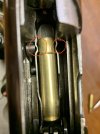DoneNOut
Well-Known Member
I have a Remington Auto 8 35 Remington. It is gouging the brass right where the shoulder meets the neck. So, logic dictates it's a deposit of something. I'm going to buy a bore scope, but after I find said deposit, what's the best way to remove it from the chamber?

Last edited:

